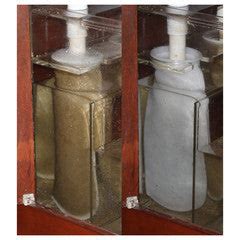The Importance of Cleaning Your Aquarium Filter Socks: Maintaining Pristine Water Quality
Aquarium filter socks are unsung heroes in the world of fishkeeping. These simple, yet effective, filter media play a crucial role in maintaining a clean and healthy environment for your aquatic companions. Neglecting their regular cleaning, however, can quickly undermine their effectiveness and even harm your fish. This article delves into the vital importance of cleaning your aquarium filter socks and provides a practical guide to ensure optimal performance and water quality.
Why are Aquarium Filter Socks Important?
Aquarium filter socks, typically made from nylon mesh or other fine fabrics, are placed within your aquarium's filter system. Their primary function is to capture large particulate matter, preventing it from clogging other filter components and polluting your tank. This includes uneaten food, fish waste, decaying plant matter, and other debris that can quickly cloud your water and impact water parameters. By effectively trapping these larger particles, filter socks significantly improve the efficiency of your filtration system, leading to:
- Crystal-clear water: Clean socks contribute to a visually appealing tank by preventing cloudiness and improving water clarity.
- Reduced bioload: By removing large amounts of waste, you lessen the overall biological load on your beneficial bacteria colonies, preventing ammonia spikes and other water quality issues.
- Longer lifespan of other filter media: Protecting your other filter media (like ceramic rings or filter floss) from premature clogging extends their lifespan and reduces the frequency of complete filter media replacements.
- Healthier fish: A clean tank with properly functioning filtration is crucial for the health and well-being of your fish. Poor water quality can lead to disease, stress, and even death.
How Often Should You Clean Aquarium Filter Socks?
The frequency of cleaning depends on several factors, including:
- Tank size and bioload: Larger tanks and those with a higher number of fish will require more frequent cleaning.
- Type of filter sock: Some filter socks are thicker and can hold more debris, extending the cleaning interval.
- Feeding habits: Overfeeding contributes to more waste in the tank, necessitating more frequent cleaning.
As a general rule, aim to inspect your filter socks daily. If they appear significantly clogged (more than 1/3 full), it's time for a change or cleaning. In many cases, a weekly cleaning is sufficient for most setups, while some may need to clean them every 2-3 days. Don't wait until the sock is completely blocked—this could compromise your entire filtration system.
How to Clean Aquarium Filter Socks Effectively?
Cleaning your filter socks is a straightforward process:
- Preparation: Have a clean bucket or container filled with aquarium water ready. Using tank water helps to avoid shocking your beneficial bacteria.
- Removal: Carefully remove the filter sock from your filter system. Be gentle to prevent ripping.
- Rinsing: Rinse the sock thoroughly under the tap water using your hand to gently agitate it. Avoid using harsh detergents or chemicals, as these can harm beneficial bacteria and harm your fish. You may want to use a soft bristle brush for stubborn debris. Rinse until most of the debris is removed.
- Reinstallation: Once rinsed, reinstall the sock back into your filter system.
Important Note: While rinsing the sock in tank water is generally fine, discarding the old water and rinsing it in fresh, dechlorinated water is best.
What Happens If You Don't Clean Your Aquarium Filter Socks?
Ignoring filter sock maintenance can lead to several negative consequences:
- Reduced filtration: A clogged sock restricts water flow, significantly decreasing the effectiveness of your filter.
- Poor water quality: Accumulated waste will leach into your tank water, leading to ammonia and nitrite spikes, potentially causing illness or death in your fish.
- Filter malfunctions: Blocked socks can lead to increased pressure on your filter pump, potentially causing damage or failure.
- Increased maintenance: While cleaning is essential, neglecting filter socks eventually leads to much more extensive cleaning and maintenance of the entire filter system.
What are the Alternatives to Filter Socks?
While filter socks are incredibly popular, other mechanical filtration methods exist:
- Filter pads: These are disposable and easily replaced, offering a convenient alternative.
- Filter sponges: These provide both mechanical and biological filtration.
- Pre-filters: These often sit in front of other filter media, trapping larger debris.
The best option depends on your tank setup, preferences, and maintenance schedule.
How Often Should I Replace My Aquarium Filter Socks?
Filter socks themselves don't necessarily need to be replaced regularly. Unlike filter pads, which are typically disposable, a high-quality filter sock can last for months or even years with proper care. However, the material will eventually wear down from repeated cleaning and should be replaced if it starts to tear or show significant signs of damage, compromising the filtration process.
By following these guidelines and committing to regular filter sock maintenance, you can ensure your aquarium remains a clean, healthy, and thriving environment for your beloved aquatic pets. Remember, a little preventative maintenance goes a long way in ensuring the longevity and well-being of your entire aquarium ecosystem.

